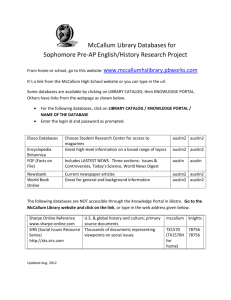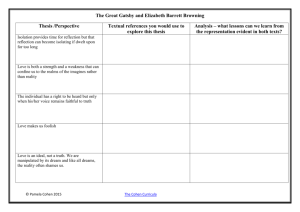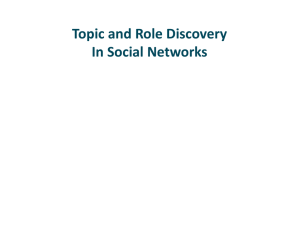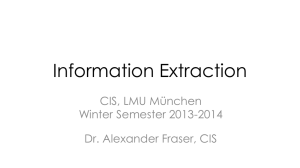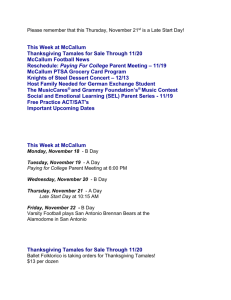Information Extraction
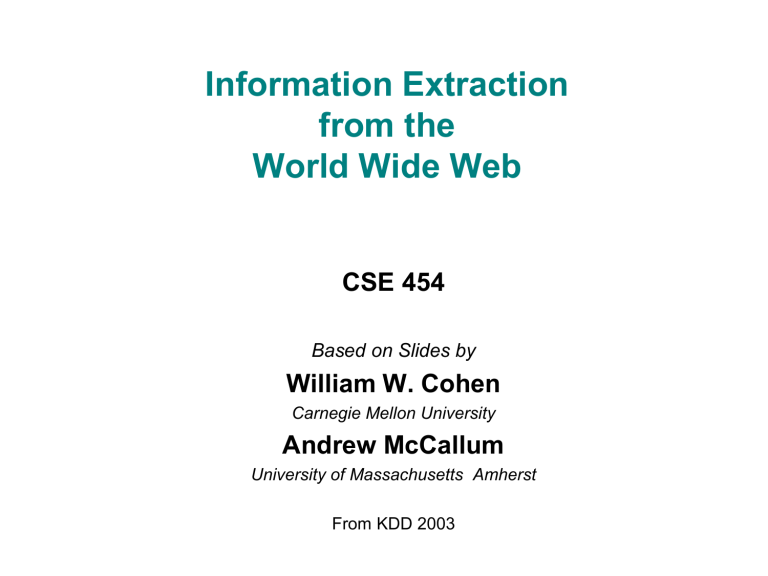
Information Extraction from the
World Wide Web
CSE 454
Based on Slides by
William W. Cohen
Carnegie Mellon University
Andrew McCallum
University of Massachusetts Amherst
From KDD 2003
Course Overview
Machine Learning
Introduction
Scaling
Bag of Words
Naïve Bayes
Hadoop
Search
Self-Supervised
Overfitting,
Ensembles,
Cotraining
Clustering Topics
Administrivia
• Proposals
– Due Thursday 10/22
– Pre-screen
– Time Estimation / Pert Chart
• Scaling Up: Way Up
– Today 3:30 – EE 105
– David “Pablo” Cohen – Google News
– “Content + Connection” Algorithms; Attribute Factoring
© Daniel S. Weld
Example: The Problem
Martin Baker, a person
Genomics job
Employers job posting form
Slides from Cohen & McCallum
Example: A Solution
Slides from Cohen & McCallum
Extracting Job Openings from the Web foodscience.com-Job2
JobTitle: Ice Cream Guru
Employer: foodscience.com
JobCategory: Travel/Hospitality
JobFunction: Food Services
JobLocation: Upper Midwest
Contact Phone: 800-488-2611
DateExtracted: January 8, 2001
Source: www.foodscience.com/jobs_midwest.html
OtherCompanyJobs: foodscience.com-Job1
Slides from Cohen & McCallum
Slides from Cohen & McCallum
What is “Information Extraction”
As a task: Filling slots in a database from sub-segments of text.
October 14, 2002, 4:00 a.m. PT
For years, Microsoft Corporation CEO Bill
Gates railed against the economic philosophy of open-source software with Orwellian fervor, denouncing its communal licensing as a
"cancer" that stifled technological innovation.
Today, Microsoft claims to "love" the opensource concept, by which software code is made public to encourage improvement and development by outside programmers. Gates himself says Microsoft will gladly disclose its crown jewels--the coveted code behind the
Windows operating system--to select customers.
"We can be open source. We love the concept of shared source," said Bill Veghte, a
Microsoft VP. "That's a super-important shift for us in terms of code access.“
Richard Stallman, founder of the Free
Software Foundation, countered saying…
NAME TITLE ORGANIZATION
Slides from Cohen & McCallum
What is “Information Extraction”
As a task: Filling slots in a database from sub-segments of text.
October 14, 2002, 4:00 a.m. PT
For years, Microsoft Corporation CEO Bill
Gates railed against the economic philosophy of open-source software with Orwellian fervor, denouncing its communal licensing as a
"cancer" that stifled technological innovation.
Today, Microsoft claims to "love" the opensource concept, by which software code is made public to encourage improvement and development by outside programmers. Gates himself says Microsoft will gladly disclose its crown jewels--the coveted code behind the
Windows operating system--to select customers.
"We can be open source. We love the concept of shared source," said Bill Veghte , a
Microsoft VP . "That's a super-important shift for us in terms of code access.“
Richard Stallman , founder of the Free
Software Foundation , countered saying…
IE
NAME TITLE ORGANIZATION
Bill Gates
Bill Veghte
CEO
VP
Microsoft
Microsoft
Richard Stallman founder Free Soft..
Slides from Cohen & McCallum
What is “Information Extraction”
As a family of techniques:
Information Extraction = segmentation + classification + clustering + association
October 14, 2002, 4:00 a.m. PT
For years, Microsoft Corporation CEO Bill
Gates railed against the economic philosophy of open-source software with Orwellian fervor, denouncing its communal licensing as a
"cancer" that stifled technological innovation.
Today, Microsoft claims to "love" the opensource concept, by which software code is made public to encourage improvement and development by outside programmers. Gates himself says Microsoft will gladly disclose its crown jewels--the coveted code behind the
Windows operating system--to select customers.
"We can be open source. We love the concept of shared source," said Bill Veghte, a
Microsoft VP. "That's a super-important shift for us in terms of code access.“
Richard Stallman, founder of the Free
Software Foundation , countered saying…
Microsoft Corporation
CEO
Bill Gates
Microsoft
Gates
Microsoft
Bill Veghte
Microsoft
VP
Richard Stallman founder
Free Software Foundation
Slides from Cohen & McCallum
What is “Information Extraction”
As a family of techniques:
Information Extraction = segmentation + classification + association + clustering
October 14, 2002, 4:00 a.m. PT
For years, Microsoft Corporation CEO Bill
Gates railed against the economic philosophy of open-source software with Orwellian fervor, denouncing its communal licensing as a
"cancer" that stifled technological innovation.
Today, Microsoft claims to "love" the opensource concept, by which software code is made public to encourage improvement and development by outside programmers. Gates himself says Microsoft will gladly disclose its crown jewels--the coveted code behind the
Windows operating system--to select customers.
"We can be open source. We love the concept of shared source," said Bill Veghte , a
Microsoft VP . "That's a super-important shift for us in terms of code access.“
Richard Stallman , founder of the Free
Software Foundation , countered saying…
Microsoft Corporation
CEO
Bill Gates
Microsoft
Gates
Microsoft
Bill Veghte
Microsoft
VP
Richard Stallman founder
Free Software Foundation
Slides from Cohen & McCallum
What is “Information Extraction”
As a family of techniques:
Information Extraction = segmentation + classification + association + clustering
October 14, 2002, 4:00 a.m. PT
For years, Microsoft Corporation CEO Bill
Gates railed against the economic philosophy of open-source software with Orwellian fervor, denouncing its communal licensing as a
"cancer" that stifled technological innovation.
Today, Microsoft claims to "love" the opensource concept, by which software code is made public to encourage improvement and development by outside programmers. Gates himself says Microsoft will gladly disclose its crown jewels--the coveted code behind the
Windows operating system--to select customers.
"We can be open source. We love the concept of shared source," said Bill Veghte , a
Microsoft VP . "That's a super-important shift for us in terms of code access.“
Richard Stallman , founder of the Free
Software Foundation , countered saying…
Microsoft Corporation
CEO
Bill Gates
Microsoft
Gates
Microsoft
Bill Veghte
Microsoft
VP
Richard Stallman founder
Free Software Foundation
Slides from Cohen & McCallum
What is “Information Extraction”
As a family of techniques:
Information Extraction = segmentation + classification + association + clustering
October 14, 2002, 4:00 a.m. PT
For years, Microsoft Corporation CEO Bill
Gates railed against the economic philosophy of open-source software with Orwellian fervor, denouncing its communal licensing as a
"cancer" that stifled technological innovation.
Today, Microsoft claims to "love" the opensource concept, by which software code is made public to encourage improvement and development by outside programmers. Gates himself says Microsoft will gladly disclose its crown jewels--the coveted code behind the
Windows operating system--to select customers.
"We can be open source. We love the concept of shared source," said Bill Veghte , a
Microsoft VP . "That's a super-important shift for us in terms of code access.“
*
*
*
*
Microsoft Corporation
CEO
Bill Gates
Microsoft
Gates
Microsoft
Bill Veghte
Microsoft
VP
Richard Stallman founder
Free Software Foundation
Richard Stallman , founder of the Free
Software Foundation , countered saying…
Slides from Cohen & McCallum
IE in Context
Create ontology
Spider
Filter by relevance
IE
Segment
Classify
Associate
Cluster
Document collection
Train extraction models
Label training data
Load DB
Database
Query,
Search
Data mine
Slides from Cohen & McCallum
IE History
Pre-Web
• Mostly news articles
– De Jong’s
FRUMP [1982]
• Hand-built system to fill Schank-style “scripts” from news wire
– Message Understanding Conference (MUC) DARPA [’87-’95], TIPSTER [’92-
’96]
• Most early work dominated by hand-built models
– E.g. SRI’s FASTUS , hand-built FSMs.
– But by 1990’s, some machine learning: Lehnert, Cardie, Grishman and then
HMMs: Elkan [Leek ’97], BBN [Bikel et al ’98]
Web
• AAAI ’94 Spring Symposium on “Software Agents”
– Much discussion of ML applied to Web. Maes, Mitchell, Etzioni.
• Tom Mitchell’s WebKB, ‘96
– Build KB’s from the Web.
• Wrapper Induction
– First by hand, then ML: [Doorenbos ‘96], Soderland ’96], [Kushmerick ’97],…
Slides from Cohen & McCallum
What makes IE from the Web Different?
Less grammar, but more formatting & linking
Newswire Web www.apple.com/retail
Apple to Open Its First Retail Store in New York City
MACWORLD EXPO, NEW YORK--July 17, 2002--
Apple's first retail store in New York City will open in
Manhattan's SoHo district on Thursday, July 18 at
8:00 a.m. EDT. The SoHo store will be Apple's largest retail store to date and is a stunning example of Apple's commitment to offering customers the world's best computer shopping experience.
"Fourteen months after opening our first retail store, our 31 stores are attracting over 100,000 visitors each week," said Steve Jobs, Apple's CEO. "We hope our SoHo store will surprise and delight both
Mac and PC users who want to see everything the
Mac can do to enhance their digital lifestyles." www.apple.com/retail/soho www.apple.com/retail/soho/theatre.html
The directory structure, link structure, formatting & layout of the Web is its own new grammar.
Slides from Cohen & McCallum
Landscape of IE Tasks (1/4):
Pattern Feature Domain
Text paragraphs without formatting
Astro Teller is the CEO and co-founder of
BodyMedia. Astro holds a Ph.D. in Artificial
Intelligence from Carnegie Mellon University, where he was inducted as a national Hertz fellow.
His M.S. in symbolic and heuristic computation and B.S. in computer science are from Stanford
University. His work in science, literature and business has appeared in international media from the New York Times to CNN to NPR.
Grammatical sentences and some formatting & links
Non-grammatical snippets, rich formatting & links
Tables
Slides from Cohen & McCallum
Landscape of IE Tasks (2/4):
Pattern Scope
Web site specific
Formatting
Amazon.com Book Pages
Genre specific
Layout
Resumes
Wide, non-specific
Language
University Names
Slides from Cohen & McCallum
Landscape of IE Tasks (3/4):
Pattern Complexity
E.g. word patterns:
Closed set
U.S. states
He was born in Alabama …
Regular set
U.S. phone numbers
Phone: (413) 545-1323
The big Wyoming sky… The CALD main office can be reached at 412-268-1299
Complex pattern
U.S. postal addresses
University of Arkansas
P.O. Box 140
Hope, AR 71802
Headquarters:
1128 Main Street, 4th Floor
Cincinnati, Ohio 45210
Ambiguous patterns, needing context and many sources of evidence
Person names
…was among the six houses sold by Hope Feldman that year.
Pawel Opalinski, Software
Engineer at WhizBang Labs.
Slides from Cohen & McCallum
Landscape of IE Tasks (4/4):
Pattern Combinations
Jack Welch will retire as CEO of General Electric tomorrow. The top role at the Connecticut company will be filled by Jeffrey Immelt.
Single entity Binary relationship N-ary record
Person: Jack Welch
Person: Jeffrey Immelt
Location: Connecticut
Relation: Person-Title
Person: Jack Welch
Title: CEO
Relation: Company-Location
Company: General Electric
Location: Connecticut
Relation: Succession
Company: General Electric
Title: CEO
Out:
In:
Jack Welsh
Jeffrey Immelt
“Named entity” extraction
Slides from Cohen & McCallum
Evaluation of Single Entity Extraction
TRUTH:
Michael Kearns and Sebastian Seung will start Monday’s tutorial, followed by Richard M. Karpe and Martin Cooke .
PRED:
Michael Kearns and Sebastian Seung will start Monday ’s tutorial, followed by Richard M. Karpe and Martin Cooke .
# correctly predicted segments 2
Precision = =
# predicted segments 6
# correctly predicted segments 2
Recall = =
# true segments 4
F1 = Harmonic mean of Precision & Recall =
1
((1/P) + (1/R)) / 2
Slides from Cohen & McCallum
State of the Art Performance
• Named entity recognition
– Person, Location, Organization, …
– F1 in high 80’s or low- to mid-90’s
• Binary relation extraction
– Contained-in (Location1, Location2)
Member-of (Person1, Organization1)
– F1 in 60’s or 70’s or 80’s
• Wrapper induction
– Extremely accurate performance obtainable
– Human effort (~30min) required on each site
Slides from Cohen & McCallum
Landscape of IE Techniques (1/1):
Models
Lexicons
Abraham Lincoln was born in Kentucky.
member?
Alabama
Alaska
…
Wisconsin
Wyoming
Classify Pre-segmented
Candidates
Abraham Lincoln was born in Kentucky.
Classifier which class?
Sliding Window
Abraham Lincoln was born in Kentucky.
Classifier which class?
Try alternate window sizes:
Boundary Models Finite State Machines Context Free Grammars
Abraham Lincoln was born in Kentucky.
BEGIN
Abraham Lincoln was born in Kentucky.
Abraham Lincoln was born in Kentucky.
Most likely state sequence?
NNP NNP V V P NP
Classifier
PP which class?
VP
NP
VP
BEGIN END BEGIN END
S
…and beyond
Any of these models can be used to capture words, formatting or both.
Slides from Cohen & McCallum
Landscape:
Focus of this Tutorial
Pattern complexity
Pattern feature domain closed set regular complex ambiguous words words + formatting formatting
Pattern scope site-specific genre-specific general
Pattern combinations entity binary n-ary
Models lexicon regex window boundary FSM CFG
Slides from Cohen & McCallum
Sliding Windows
Slides from Cohen & McCallum
Extraction by Sliding Window
E.g.
Looking for seminar location
GRAND CHALLENGES FOR MACHINE LEARNING
Jaime Carbonell
School of Computer Science
Carnegie Mellon University
3:30 pm
7500 Wean Hall
Machine learning has evolved from obscurity in the 1970s into a vibrant and popular discipline in artificial intelligence during the 1980s and 1990s. As a result of its success and growth, machine learning is evolving into a collection of related disciplines: inductive concept acquisition, analytic learning in problem solving (e.g. analogy, explanation-based learning), learning theory (e.g. PAC learning), genetic algorithms, connectionist learning, hybrid systems, and so on.
CMU UseNet Seminar Announcement
Slides from Cohen & McCallum
Extraction by Sliding Window
E.g.
Looking for seminar location
GRAND CHALLENGES FOR MACHINE LEARNING
Jaime Carbonell
School of Computer Science
Carnegie Mellon University
3:30 pm
7500 Wean Hall
Machine learning has evolved from obscurity in the 1970s into a vibrant and popular discipline in artificial intelligence during the 1980s and 1990s. As a result of its success and growth, machine learning is evolving into a collection of related disciplines: inductive concept acquisition, analytic learning in problem solving (e.g. analogy, explanation-based learning), learning theory (e.g. PAC learning), genetic algorithms, connectionist learning, hybrid systems, and so on.
CMU UseNet Seminar Announcement
Slides from Cohen & McCallum
Extraction by Sliding Window
E.g.
Looking for seminar location
GRAND CHALLENGES FOR MACHINE LEARNING
Jaime Carbonell
School of Computer Science
Carnegie Mellon University
3:30 pm
7500 Wean Hall
Machine learning has evolved from obscurity in the 1970s into a vibrant and popular discipline in artificial intelligence during the 1980s and 1990s. As a result of its success and growth, machine learning is evolving into a collection of related disciplines: inductive concept acquisition, analytic learning in problem solving (e.g. analogy, explanation-based learning), learning theory (e.g. PAC learning), genetic algorithms, connectionist learning, hybrid systems, and so on.
CMU UseNet Seminar Announcement
Slides from Cohen & McCallum
Extraction by Sliding Window
E.g.
Looking for seminar location
GRAND CHALLENGES FOR MACHINE LEARNING
Jaime Carbonell
School of Computer Science
Carnegie Mellon University
3:30 pm
7500 Wean Hall
Machine learning has evolved from obscurity in the 1970s into a vibrant and popular discipline in artificial intelligence during the 1980s and 1990s. As a result of its success and growth, machine learning is evolving into a collection of related disciplines: inductive concept acquisition, analytic learning in problem solving (e.g. analogy, explanation-based learning), learning theory (e.g. PAC learning), genetic algorithms, connectionist learning, hybrid systems, and so on.
CMU UseNet Seminar Announcement
Slides from Cohen & McCallum
A “Naïve Bayes” Sliding Window Model
[Freitag 1997]
… 00 : pm Place : Wean Hall Rm 5409 Speaker : Sebastian Thrun w t-m w t-1 w t w t+n w t+n+1 w t+n+m
… suffix prefix contents
Estimate Pr(LOCATION|window) using Bayes rule
Try all “reasonable” windows (vary length, position)
Assume independence for length, prefix words, suffix words, content words
Estimate from data quantities like: Pr(“Place” in prefix|LOCATION)
If
P(“Wean Hall Rm 5409” = LOCATION) is above some threshold, extract it.
Other examples of sliding window: [Baluja et al 2000]
(decision tree over individual words & their context)
Slides from Cohen & McCallum
“Naïve Bayes” Sliding Window Results
Domain: CMU UseNet Seminar Announcements
GRAND CHALLENGES FOR MACHINE LEARNING
Jaime Carbonell
School of Computer Science
Carnegie Mellon University
3:30 pm
7500 Wean Hall
Machine learning has evolved from obscurity in the 1970s into a vibrant and popular discipline in artificial intelligence during the 1980s and 1990s. As a result of its success and growth, machine learning is evolving into a collection of related disciplines: inductive concept acquisition, analytic learning in problem solving (e.g. analogy, explanation-based learning), learning theory (e.g. PAC learning), genetic algorithms, connectionist learning, hybrid systems, and so on.
Field F1
Person Name: 30%
Location: 61%
Start Time: 98%
Slides from Cohen & McCallum
Realistic sliding-window-classifier IE
• What windows to consider?
– all windows containing as many tokens as the shortest example, but no more tokens than the longest example
• How to represent a classifier? It might:
– Restrict the length of window;
– Restrict the vocabulary or formatting used before/after/inside window;
– Restrict the relative order of tokens, etc.
• Learning Method
– SRV: Top-Down Rule Learning [Frietag AAAI ‘98]
– Rapier: Bottom-Up [Califf & Mooney, AAAI ‘99]
Slides from Cohen & McCallum
Rapier: results – precision/recall
Slides from Cohen & McCallum
Rule-learning approaches to slidingwindow classification: Summary
• SRV, Rapier, and WHISK
[Soderland KDD ‘97]
– Representations for classifiers allow restriction of the relationships between tokens, etc
– Representations are carefully chosen subsets of even more powerful representations based on logic programming (ILP and Prolog)
– Use of these “heavyweight” representations is complicated , but seems to pay off in results
• Can simpler representations for classifiers work?
Slides from Cohen & McCallum
BWI: Learning to detect boundaries
[Freitag & Kushmerick, AAAI 2000]
• Another formulation: learn three probabilistic classifiers:
– START(i) = Prob( position i starts a field)
– END(j) = Prob( position j ends a field)
– LEN(k) = Prob( an extracted field has length k )
• Then score a possible extraction (i,j) by
START(i) * END(j) * LEN(j-i)
• LEN(k) is estimated from a histogram
Slides from Cohen & McCallum
BWI: Learning to detect boundaries
• BWI uses boosting to find “detectors” for
START and END
• Each weak detector has a BEFORE and
AFTER pattern (on tokens before/after position i).
• Each “pattern” is a sequence of
– tokens and/or
– wildcards like: anyAlphabeticToken, anyNumber, …
• Weak learner for “patterns” uses greedy search (+ lookahead) to repeatedly extend a pair of empty BEFORE,AFTER patterns
Slides from Cohen & McCallum
BWI: Learning to detect boundaries
Field F1
Person Name: 30%
Location: 61%
Start Time: 98%
Slides from Cohen & McCallum
Problems with Sliding Windows and Boundary Finders
• Decisions in neighboring parts of the input are made independently from each other.
– Naïve Bayes Sliding Window may predict a
“seminar end time” before the “seminar start time”.
– It is possible for two overlapping windows to both be above threshold.
– In a Boundary-Finding system, left boundaries are laid down independently from right boundaries, and their pairing happens as a separate step.
Slides from Cohen & McCallum
Finite State Machines
Slides from Cohen & McCallum
Hidden Markov Models (HMMs) standard sequence model in genomics, speech, NLP, …
Finite state model
Graphical model
...
S t - 1
S t
S t+1 transitions
...
observations
...
O t -1
O t
O t +1
Generates:
State sequence
Observation sequence o
1 o
2 o
3 o
4 o
5 o
6 o
7 o
8
P ( s
,
o )
t
| o |
1
P ( s t
| s t
1
) P ( o t
| s t
)
Parameters: for all states S={s
1
,s
2
,…}
Start state probabilities: P(s t
)
Transition probabilities:
P(s t
|s t-1
)
Observation (emission) probabilities: P(o t
|s t
)
Training:
Usually a multinomial over atomic, fixed alphabet
IE with Hidden Markov Models
Given a sequence of observations:
Yesterday Pedro Domingos spoke this example sentence.
and a trained HMM: person name location name background
Find the most likely state sequence: (Viterbi) arg max s
P ( s
,
o )
Yesterday Pedro Domingos spoke this example sentence.
Any words said to be generated by the designated “person name” state extract as a person name:
Person name: Pedro Domingos
Slides from Cohen & McCallum
HMM Example: “Nymble”
Task: Named Entity Extraction
[Bikel, et al 1998],
[BBN “IdentiFinder”] start-ofsentence
Person
Org
(Five other name classes)
Other end-ofsentence
Train on ~500k words of news wire text.
Results: Case Language
Mixed English
Upper English
Mixed Spanish
F1 .
93%
91%
90%
Transition probabilities
Observation probabilities
P(s t
| s t-1
, o t-1
) P(o t
| s t
, s t-1
) or P(o t
| s t
, o t-1
)
Back-off to: Back-off to:
P(s t
| s t-1
)
P(s t
)
P(o
P(o t t
| s
) t
)
Other examples of shrinkage for HMMs in IE:
[Freitag and McCallum ‘99]
Slides from Cohen & McCallum
We want More than an Atomic View of Words
Would like richer representation of text: many arbitrary, overlapping features of the words.
identity of word ends in “-ski” is capitalized is part of a noun phrase is in a list of city names is “Wisniewski” is under node X in WordNet is in bold font part of noun phrase is indented is in hyperlink anchor last person name was female next two words are “and Associates”
S t - 1 ends in
“-ski”
O t -1
S t
O t
S t+1
O t +1
…
…
Slides from Cohen & McCallum
Problems with Richer Representation and a Joint Model
These arbitrary features are not independent.
– Multiple levels of granularity (chars, words, phrases)
– Multiple dependent modalities (words, formatting, layout)
– Past & future
Two choices:
Model the dependencies.
Each state would have its own
Bayes Net. But we are already starved for training data!
S t - 1
S t
S t+1
Ignore the dependencies.
This causes “over-counting” of evidence (ala naïve Bayes).
Big problem when combining evidence, as in Viterbi!
S t - 1
S t
S t+1
O t -1
O t
O t +1
O t -1
O t t +1
Conditional Sequence Models
• We prefer a model that is trained to maximize a conditional probability rather than joint probability:
P(s|o) instead of P(s,o):
– Can examine features, but not responsible for generating them.
– Don’t have to explicitly model their dependencies.
– Don’t “waste modeling effort” trying to generate what we are given at test time anyway.
Slides from Cohen & McCallum
Conditional Finite State Sequence Models
[McCallum, Freitag & Pereira, 2000]
[Lafferty, McCallum, Pereira 2001]
From HMMs to CRFs s
s
1
, s
2
,...
s n
Joint
o
o
1
, o
2
,...
o n
P ( s
,
o )
|
o | t
1
P ( s t
| s t
1
) P ( o t
| s t
)
O t-1
S t-1
O t
S t
O t+1
S t+1
...
...
Conditional
P ( s
|
o )
P
1
( o )
| o | t
1
P ( s t
| s t
1
) P ( o t
| s t
)
Z (
1
o ) t
| o |
1
s
( s t
, s t
1
)
o
( o t
, s t
) where
o
( t )
exp
k
k f k
( s t
, o t
)
O t-1
S t-1
O t
S t
S t+1
...
O t+1
...
(A super-special case of
Conditional Random Fields.)
Slides from Cohen & McCallum
Conditional Random Fields
[Lafferty, McCallum, Pereira 2001]
1. FSM special-case: linear chain among unknowns, parameters tied across time steps.
S t
S t+1
S t+2
S t+3
S t+4
P ( s
|
o )
Z (
1
o ) t
| o |
1 exp
k
k
O = O t
, O t+1
, O t+2
, O t+3
, O t+4 f k
( s t
, s t
1
,
o , t )
2. In general:
CRFs = "Conditionally-trained Markov Network" arbitrary structure among unknowns
3. Relational Markov Networks [Taskar, Abbeel, Koller 2002]:
Parameters tied across hits from SQL-like queries ("clique templates")
4. Markov Logic Networks [Richardson & Domingos]:
Weights on arbitrary logical sentences
Slides from Cohen & McCallum
Feature Functions
Example
f k
(
s t
,
s t
1
,
o
,
t
) :
f
Capitalize d, s i
, s j
( s t
, s t
1
,
o , t )
1 if Capitalize d( o t
)
s i
s t
1
s j
s t
0 otherwise o = Yesterday Pedro Domingos spoke this example sentence.
o
1 o
2 o
3 o
4 o
5 o
6 o
7 s
1 s
3 s
2 s
4 f
Capitalize d , s
1
, s
3
( s
1
, s
2
,
o , 2 )
1
Slides from Cohen & McCallum
Learning Parameters of CRFs
Maximize log-likelihood of parameters
{ k
} given training data D
L
s , o
D log
Z
1
( o ) t
|
o |
1 exp
k
k f k
( s t
, s t
1
,
o , t )
k
2
2
k
2
Log-likelihood gradient:
L
k
s
o ,
D
# k
where # k
( s
,
( s
,
o )
o )
t i s
f k
'
( s t
P
1
,
( s
s t
|'
o
( i )
) # k
,
o , t )
( s
' ,
o
( i )
)
k
2
Methods:
• iterative scaling (quite slow)
• conjugate gradient (much faster) [Sha & Pereira 2002] & [Malouf 2002]
• limited-memory quasi-Newton methods, BFGS (super fast)
Slides from Cohen & McCallum
General CRFs vs. HMMs
• More general and expressive modeling technique
• Comparable computational efficiency
• Features may be arbitrary functions of any or all observations
• Parameters need not fully specify generation of observations; require less training data
• Easy to incorporate domain knowledge
• State means only “state of process”, vs
“state of process” and “observational history I’m keeping”
Slides from Cohen & McCallum
Person name Extraction
[McCallum 2001, unpublished]
Slides from Cohen & McCallum
Person name Extraction
Slides from Cohen & McCallum
Features in Experiment
Capitalized
Mixed Caps
All Caps
Initial Cap
Xxxxx
XxXxxx
XXXXX
X….
xxx5 xxxx
Contains Digit
All lowercase
Initial
Punctuation
Period .
X
.,:;!(), etc
Comma
Apostrophe ‘
,
Dash -
Preceded by HTML tag
Character n-gram classifier says string is a person name (80% accurate)
In stopword list
(the, of, their, etc)
In honorific list
(Mr, Mrs, Dr, Sen, etc)
In person suffix list
(Jr, Sr, PhD, etc)
In name particle list
(de, la, van, der, etc)
In Census lastname list; segmented by P(name)
In Census firstname list; segmented by P(name)
In locations lists
(states, cities, countries)
Hand-built FSM person-name extractor says yes,
(prec/recall ~ 30/95)
Conjunctions of all previous feature pairs, evaluated at the current time step.
Conjunctions of all previous feature pairs, evaluated at current step and one step ahead.
All previous features, evaluated two steps ahead.
All previous features, evaluated one step behind.
In company name list
(“J. C. Penny”)
Total number of features = ~500k
In list of company suffixes
(Inc, & Associates, Foundation)
Slides from Cohen & McCallum
Training and Testing
• Trained on 65k words from 85 pages, 30 different companies’ web sites.
• Training takes 4 hours on a 1 GHz Pentium.
• Training precision/recall is 96% / 96%.
• Tested on different set of web pages with similar size characteristics.
• Testing precision is 92 – 95%, recall is 89 – 91%.
Slides from Cohen & McCallum
Table Extraction from Government Reports
Cash receipts from marketings of milk during 1995 at $19.9 billion dollars, was slightly below 1994. Producer returns averaged $12.93 per hundredweight,
$0.19 per hundredweight below 1994. Marketings totaled 154 billion pounds,
1 percent above 1994. Marketings include whole milk sold to plants and dealers as well as milk sold directly to consumers.
An estimated 1.56 billion pounds of milk were used on farms where produced,
8 percent less than 1994. Calves were fed 78 percent of this milk with the remainder consumed in producer households.
Milk Cows and Production of Milk and Milkfat:
United States, 1993-95
--------------------------------------------------------------------------------
: : Production of Milk and Milkfat 2/
: Number :-------------------------------------------------------
Year : of : Per Milk Cow : Percentage : Total
:Milk Cows 1/:-------------------: of Fat in All :------------------
: : Milk : Milkfat : Milk Produced : Milk : Milkfat
--------------------------------------------------------------------------------
: 1,000 Head --- Pounds --Percent Million Pounds
:
1993 : 9,589 15,704 575 3.66 150,582 5,514.4
1994 : 9,500 16,175 592 3.66 153,664 5,623.7
1995 : 9,461 16,451 602 3.66 155,644 5,694.3
--------------------------------------------------------------------------------
1/ Average number during year, excluding heifers not yet fresh.
2/ Excludes milk sucked by calves.
Slides from Cohen & McCallum
Table Extraction from Government Reports
[Pinto, McCallum, Wei, Croft, 2003]
100+ documents from www.fedstats.gov
Cash receipts from marketings of milk during 1995 at $19.9 billion dollars, was slightly below 1994. Producer returns averaged $12.93 per hundredweight,
$0.19 per hundredweight below 1994. Marketings totaled 154 billion pounds,
1 percent above 1994. Marketings include whole milk sold to plants and dealers as well as milk sold directly to consumers.
An estimated 1.56 billion pounds of milk were used on farms where produced,
8 percent less than 1994. Calves were fed 78 percent of this milk with the remainder consumed in producer households.
Milk Cows and Production of Milk and Milkfat:
United States, 1993-95
--------------------------------------------------------------------------------
: : Production of Milk and Milkfat 2/
-------------------------------------------------------
Year : of : Per Milk Cow : Percentage : Total
-------------------: of Fat in All :------------------
: : Milk : Milkfat : Milk Produced : Milk : Milkfat
--------------------------------------------------------------------------------
Pounds --Percent Million Pounds
CRF
Labels:
• Non-Table
• Table Title
• Table Header
• Table Data Row
• Table Section Data Row
• Table Footnote
• ... (12 in all)
Features:
• Percentage of digit chars
• Percentage of alpha chars
• Indented
• Contains 5+ consecutive spaces
• Whitespace in this line aligns with prev.
• ...
• Conjunctions of all previous features,
Table Extraction Experimental Results
[Pinto, McCallum, Wei, Croft, 2003]
HMM
Line labels, percent correct
65 %
Stateless
MaxEnt
CRF w/out conjunctions
CRF
85 %
52 %
95 %
Slides from Cohen & McCallum
Named Entity Recognition
Reuters stories on international news Train on ~300k words
CRICKET -
MILLNS SIGNS FOR BOLAND
CAPE TOWN 1996-08-22
South African provincial side
Boland said on Thursday they had signed Leicestershire fast bowler David Millns on a one year contract.
Millns , who toured Australia with
England A in 1992, replaces former England all-rounder
Phillip DeFreitas as Boland 's overseas professional.
Labels:
PER
ORG
LOC
MISC
Examples:
Yayuk Basuki
Innocent Butare
3M
KDP
Leicestershire
Leicestershire
Nirmal Hriday
The Oval
Java
Basque
1,000 Lakes Rally
Slides from Cohen & McCallum
Automatically Induced Features
[McCallum 2003]
Index Feature
0
5
20
75
100
200
500
711 inside-noun-phrase (o t-1
) stopword (o t
) capitalized (o t+1
) word=the (o t
) in-person-lexicon (o t-1
) word=in (o t+2
) word=Republic (o t+1
) word=RBI (o t
) & header=BASEBALL
1027 header=CRICKET (o t
) & in-English-county-lexicon (o t
)
1298 company-suffix-word (firstmention t+2
)
4040 location (o t
) & POS=NNP (o t
) & capitalized (o t
) & stopword (o t-1
)
4945 moderately-rare-first-name (o t-1
) & very-common-last-name (o t
)
4474 word=the (o t-2
) & word=of (o t
)
Slides from Cohen & McCallum
Named Entity Extraction Results
[McCallum & Li, 2003]
Method
BBN's Identifinder, word features
CRFs word features, w/out Feature Induction
CRFs many features, w/out Feature Induction
CRFs many candidate features with Feature Induction
F1
79%
80%
# parameters
~500k
~500k
75%
90%
~3 million
~60k
Slides from Cohen & McCallum
Inducing State-Transition Structure
[Chidlovskii, 2000]
K-reversible grammars
Structure learning for
HMMs + IE
[Seymore et al 1999]
[Frietag & McCallum 2000]
Slides from Cohen & McCallum
Limitations of Finite State Models
• Finite state models have a linear structure
• Web documents have a hierarchical structure
– Are we suffering by not modeling this structure more explicitly?
• How can one learn a hierarchical extraction model?
Slides from Cohen & McCallum
IE Resources
• Data
– RISE, http://www.isi.edu/~muslea/RISE/index.html
– Linguistic Data Consortium (LDC)
• Penn Treebank, Named Entities, Relations, etc.
– http://www.biostat.wisc.edu/~craven/ie
– http://www.cs.umass.edu/~mccallum/data
• Code
– TextPro, http://www.ai.sri.com/~appelt/TextPro
– MALLET, http://www.cs.umass.edu/~mccallum/mallet
– SecondString
, http://secondstring.sourceforge.net/
• Both
– http://www.cis.upenn.edu/~adwait/penntools.html
Slides from Cohen & McCallum
•
•
•
•
•
•
•
•
•
•
•
•
•
•
•
•
•
•
•
References
[Bikel et al 1997] Bikel, D.; Miller, S.; Schwartz, R.; and Weischedel, R. Nymble: a high-performance learning name-finder. In
Proceedings of ANLP’97 , p194-201.
[Califf & Mooney 1999], Califf, M.E.; Mooney, R.: Relational Learning of Pattern-Match Rules for Information Extraction, in
Proceedings of the Sixteenth National Conference on Artificial Intelligence (AAAI-99).
[Cohen, Hurst, Jensen, 2002] Cohen, W.; Hurst, M.; Jensen, L.: A flexible learning system for wrapping tables and lists in HTML documents. Proceedings of The Eleventh International World Wide Web Conference (WWW-2002)
[Cohen, Kautz, McAllester 2000] Cohen, W; Kautz, H.; McAllester, D.: Hardening soft information sources. Proceedings of the
Sixth International Conference on Knowledge Discovery and Data Mining (KDD-2000).
[Cohen, 1998] Cohen, W.: Integration of Heterogeneous Databases Without Common Domains Using Queries Based on Textual
Similarity, in Proceedings of ACM SIGMOD-98 .
[Cohen, 2000a] Cohen, W.: Data Integration using Similarity Joins and a Word-based Information Representation Language,
ACM Transactions on Information Systems , 18(3).
[Cohen, 2000b] Cohen, W. Automatically Extracting Features for Concept Learning from the Web, Machine Learning:
Proceedings of the Seventeeth International Conference (ML-2000).
[Collins & Singer 1999] Collins, M.; and Singer, Y. Unsupervised models for named entity classification. In Proceedings of the
Joint SIGDAT Conference on Empirical Methods in Natural Language Processing and Very Large Corpora , 1999.
[De Jong 1982] De Jong, G. An Overview of the FRUMP System. In: Lehnert, W. & Ringle, M. H. (eds), Strategies for Natural
Language Processing . Larence Erlbaum, 1982, 149-176.
[Freitag 98] Freitag, D: Information extraction from HTML: application of a general machine learning approach, Proceedings of the
Fifteenth National Conference on Artificial Intelligence (AAAI-98).
[Freitag, 1999], Freitag, D. Machine Learning for Information Extraction in Informal Domains . Ph.D. dissertation, Carnegie Mellon
University.
[Freitag 2000], Freitag, D: Machine Learning for Information Extraction in Informal Domains, Machine Learning 39(2/3): 99-101
(2000).
Freitag & Kushmerick, 1999] Freitag, D; Kushmerick, D.: Boosted Wrapper Induction. Proceedings of the Sixteenth National
Conference on Artificial Intelligence (AAAI-99)
[Freitag & McCallum 1999] Freitag, D. and McCallum, A. Information extraction using HMMs and shrinakge. In Proceedings
AAAI-99 Workshop on Machine Learning for Information Extraction. AAAI Technical Report WS-99-11.
[Kushmerick, 2000] Kushmerick, N: Wrapper Induction: efficiency and expressiveness, Artificial Intelligence , 118(pp 15-68).
[Lafferty, McCallum & Pereira 2001] Lafferty, J.; McCallum, A.; and Pereira, F., Conditional Random Fields: Probabilistic Models for Segmenting and Labeling Sequence Data, In Proceedings of ICML-2001 .
[Leek 1997] Leek, T. R. Information extraction using hidden Markov models . Master’s thesis. UC San Diego.
[McCallum, Freitag & Pereira 2000] McCallum, A.; Freitag, D.; and Pereira. F., Maximum entropy Markov models for information extraction and segmentation, In Proceedings of ICML-2000
[Miller et al 2000] Miller, S.; Fox, H.; Ramshaw, L.; Weischedel, R. A Novel Use of Statistical Parsing to Extract Information from
Text. Proceedings of the 1st Annual Meeting of the North American Chapter of the ACL (NAACL), p. 226 - 233.
Slides from Cohen & McCallum
